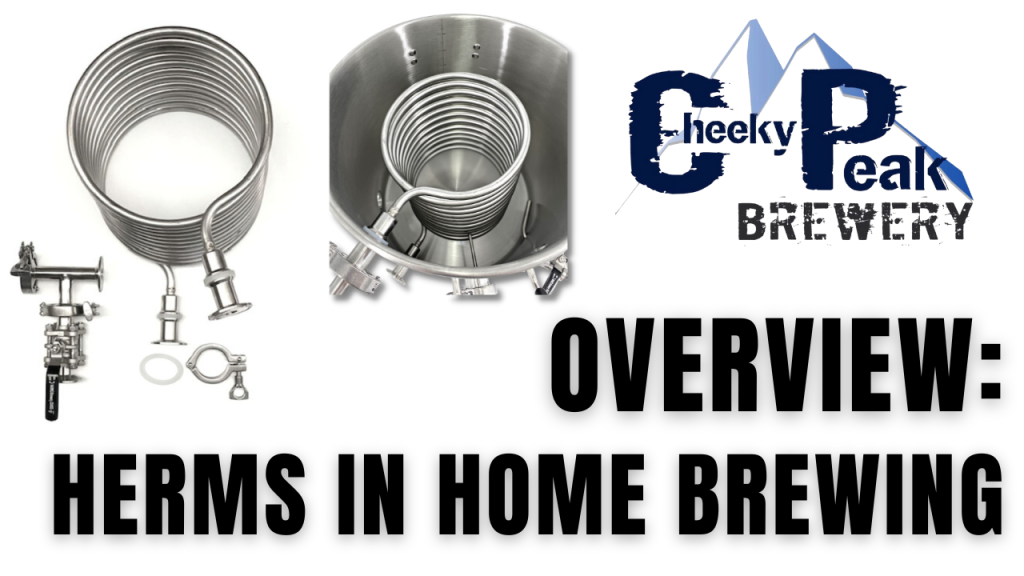Home brewing is a fascinating and rewarding hobby that has been around for centuries. With the rise of craft beer and the increasing demand for unique and high-quality beers, home brewers are constantly seeking new and innovative techniques to improve their brewing process and elevate the taste of their beer. This has led to the development of advanced brewing techniques and equipment, such as the HERMS system.
HERMS is a highly effective method of heating and maintaining the desired mash temperature during the brewing process. This technique has become increasingly popular among home brewers due to its ability to provide accurate temperature control and a gentler heating process, which helps eliminate scorching of the wort and improves the overall flavour of the beer. Furthermore, HERMS allows for more efficient use of energy, which reduces energy costs and minimizes the impact on the environment.
In this article, we will explore how HERMS works, its advantages in brewing, and how at Cheeky Peak Brewery we have developed a range of dedicated HERMS coil equipment that is simple to install with the use of our QuickSeal designed fittings.

Whether you are a seasoned home brewer or just starting, HERMS can help take your brewing process to the next level and create the highest quality craft beer at home. So, let’s dive into the details and discover the benefits of using a HERMS system in home brewing.
How Does HERMS Work:
In traditional brewing methods, the mash is heated by direct contact with a heat source, such as a flame or an electric element. Direct heating contact can potentially result in the scorching of the wort, which can give your beer a caramelized or burnt flavour, negatively impacting the taste and overall quality. However, with HERMS, the heating process is more indirect. The mash wort is pumped from the mash tun through a heat exchanger “HERMS” coil that is immersed in hot water. The hot water heats the mash wort as it passes through the coil which is then recirculated back to the mash tun.
The HERMS system has three main components: the mash tun, the heat exchanger HERMS coil, and the hot liquor tank (HLT). The mash tun is where the grains are mixed with water to create the mash wort. The heat exchanger HERMS coil is where the mash is heated as it pumped through, and the HLT is where the hot water and HERMS coil is stored.

The HLT is typically fitted with a temperature control system, which allows brewers to adjust the temperature of the water as needed. The temperature control system generally consists of an element in the HLT which is controlled to a desired temperature with a dedicated temperature controller. This temperature control system is important because different types of beer require different temperatures during the brewing process. For example, ales typically require a mash temperature between 66°C and 68°C, while lagers require a lower temperature range of 63°C to 65°C. By adjusting the temperature of the water in the HLT, brewers can easily achieve the desired temperature range for the specific type of beer they are brewing.

Furthermore, the ability to control the temperature of the HLT also means that brewers can maintain a consistent temperature throughout the mashing process. This is important because temperature fluctuations can lead to inconsistencies in the final product, resulting in off-flavors or other defects. With HERMS, brewers can ensure that the temperature of the mash remains constant throughout the brewing process, resulting in a more consistent and high-quality beer.
The Advantages of HERMS in Brewing:
The advantages of using a HERMS system in brewing are numerous and can greatly enhance the brewing process. One of the most significant advantages of using a HERMS system is its ability to provide accurate and consistent temperature control during the mashing process. This is critical for activating the enzymes in the mash properly, which is necessary for achieving the desired flavour profile.
The temperature of the mash can be easily adjusted by adjusting the temperature of the hot water in the heat exchanger, which is a feature unique to HERMS. This allows brewers to easily adjust the temperature to suit their brewing needs and to achieve the desired flavour profile. The ability to precisely control the temperature of the mash also means that brewers can experiment with different temperature ranges and create new and unique beer styles.
Another key advantage of using HERMS is its gentler heating process. In traditional brewing methods, direct heating contact can have a negative impact on the quality of the wort by potentially scorching or burning the mash. This can lead to off-flavors or other defects in the final product. However, with HERMS, the heat source is indirect, and the heating process is gentler, reducing the risk of scorching or burning the mash. This helps preserve the quality of the wort and the overall flavour of the beer.
HERMS also enables more efficient use of energy, which is important for brewers who are environmentally conscious. The hot water used in the heat exchange process will also be used in other brewing processes such as sparging and cleaning at the end of your brew day. This means that less energy is required to perform brewing processes, reducing energy costs and minimizing the impact on the environment. Additionally, by using less energy, HERMS can help reduce the carbon footprint of your brewing process.
In summary, the advantages of using a HERMS system in brewing include accurate and consistent temperature control, a gentler heating process that preserves the quality of the wort and the overall flavour of the beer, and more efficient use of energy. These benefits make HERMS a popular choice among home brewers who are seeking to improve the quality of their beer and reduce their impact on the environment.
Setting up and running a HERMS System at Home:
Setting up a HERMS system at home can be a rewarding experience, but it does require some specialized equipment and knowledge. At Cheeky Peak we have now simplified the process for you by creating an easy to install DIY HERMS Package or basic HERMS Coil that can be installed into any brewing kettle you already have at home. Prior to this, installing a HERMS coil could prove to be a difficult task with complicated threaded fittings that would have the potential for leaking if not installed correctly. However, if you are looking for a full solution without having to install your own HERMS coil we have also created a range of HLT kettles here.
Once you have your equipment installed, you can begin to setup your pump and hosing to run the HERMS system loop. It’s important to make sure that first the HERMS coil is fully immersed in the water within the HLT. After that, connect the pump inlet to the mash tun outlet and the outlet of the pump to the inlet of the HERMS coil. The outlet of the HERMS coil will then direct to the inlet of the mash tun to complete the HERMS loop. This HERMS loop will pump wort from the mash tun into the HERMS coil and back into the mash tun.
Before turning on the pump you will first need to heat the HLT to your desired temperature. This can be done using a dedicated temperature controller. Once the hot liquor tank has reached the desired temperature, turn on the pump. The mash water will be circulated through the HERMS coil, where it will be heated by the hot water in the HLT. The heated mash will then be recirculated back to the mash tun.
As the mash circulates through the system, it’s important to monitor the temperature and make any temperature adjustments to the HLT as required to maintain your desired mash temperature.
Start your HERMS System Today:
Home brewing is a hobby that has been around for centuries and has gained popularity with the rise of craft beer and demand for unique and high-quality beers. HERMS (Heat Exchanger Recirculating Mash System) is a highly effective method of heating and maintaining the desired mash temperature during the brewing process. It is becoming increasingly popular among home brewers due to its ability to provide accurate temperature control, a gentler heating process, and more efficient use of energy. HERMS allows for more consistent and high-quality beer by activating the enzymes in the mash properly, preserving the quality of the wort, and enabling brewers to experiment with different temperature ranges. While setting up a HERMS system requires specialized equipment and knowledge, Cheeky Peak has now developed a range of dedicated HERMS equipment to make the setup simple and efficient for anyone at home.










